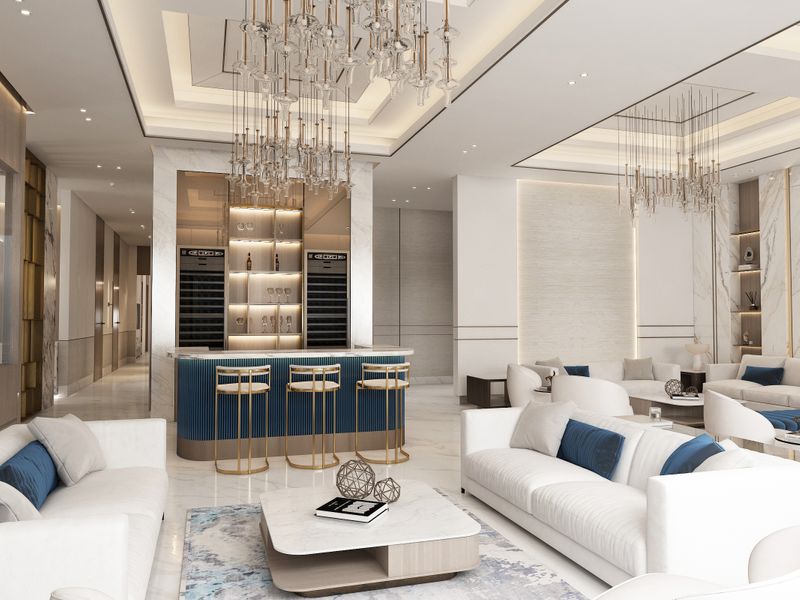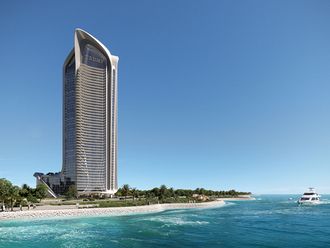
Highlights
In a world driven by constant change, Ashish Kohli’s creations stand as timeless testaments to the amalgamation of luxury, tranquility, and the enduring wisdom of Vastu
In the realm of architecture and design, there are those whose influence transcends trends, and whose creations bear the mark of a distinctive vision. Ashish Kohli, the enigmatic founder of Ashish Kohli Design (AKD), is behind some of the most coveted living spaces in the UAE in recent times. Yet, the man has consciously stayed away from the glare of publicity all this time, even while crafting ultra-luxurious villas and apartments.
An exceptional creator, who marries architectural grandeur with the ancient science of Vastu, his work goes beyond aesthetics — it’s an exploration of equilibrium and positive energy. With a portfolio boasting projects that seamlessly blend luxury with holistic living, Kohli has redefined opulence through a lens of cultural and spiritual sensitivity.
In this interview, we unravel the mystery behind Ashish Kohli’s design’s ethos — how he translates the ancient wisdom of Vastu into contemporary abodes, and the challenges he faces while maintaining the delicate balance between tradition and innovation.

Can you elaborate on how architectural principles influence your design process, and how they manifest in your projects?
I have been designing mansions for the past two and a half decades and my designs have always been evolving. However, from the first day that I began designing my projects the major principles of architecture always influenced the design process and I have placed them in the following order of preference. I have always kept optimal space management at the top keeping in mind the principles of Vastu while ensuring the client’s preferences are balanced with functionality.
Over the years, we have also progressed and we keep updating our knowledge of the ongoing trends in design, form and furniture that affect our aesthetic approach in a major way. We also keep an eye out for the latest in technology trends from home automation, home theatres, tech gadgets and appliances and use the best of brand partners from around the world to keep us on the top at incorporating these in our projects.

Ashish Kohli Design is known for its unique aesthetic. How do you ensure that your design projects reflect this aesthetic while also meeting the individual preferences of your clients?
AKD strives to create designs that are timeless, minimalistic and add personalised stories to spaces. Our utmost priority is to understand our clientele, their style and preferences, while simultaneously ensuring elements of our own aesthetic be added to the work.
Creating material and image mood boards as well as provisional 3D visualisations of spaces are a crucial part of creating a balance between the aesthetic requirement of the client, and our company’s design language. For us, simplicity is everything. We believe in fabricating spaces that reflect an airy, refined and grand appeal, while also capturing the essence of our client’s ideas and taste. I am a true fan of high ceilings and large openings for doors and glazings.

Designing aesthetically pleasing spaces that are also functional requires a balance. Is it easy to effectively optimise space utilisation without compromising the visual appeal and what is needed to make the process seamless?
The functionality of a space, whether it’s residential, commercial or industrial, is always an important consideration when conceptualising a space. The best designs tend to follow a balance between aesthetics and functionality - and at AKD, we conduct this methodology in all our designs.
It isn’t always easy to create this balance, but it’s also not impossible. We use specific tools to optimise a space, while still holding its aesthetic value; such as, the placement of furniture, the use of subdued base colours with secondary accent colours, creating niches and shelving within walls, and adding hidden doors, are a few examples amongst others. The most important step is perfecting the 2D layout before executing a design. This step makes the process of designing the interior of a space coherent and flawless, as once the layout is complete, we can focus on adapting the visual appeal to fit the function and size of the space.
Your company values cultural sensibility in design. How do you incorporate elements of local culture or the client’s background into your projects, while maintaining a cohesive and harmonious design language?
It’s exceptionally important to us to take into account the diverse experiences and perspectives of our clients and the local community. Our project aesthetics range from contemporary, modern classic and traditional designs, with a focus on including the client’s individuality into each creation. Adding artworks, religious/cultural symbols or spaces that are unique to the user and their background is one way of showcasing this. Our designers are consistently aware of the different viewpoints that come with such a diverse population, and are cautious to frame our designs to reflect the community and heritage we’re a part of.
Can you discuss a challenging design decision you’ve made where the interplay between architectural principles, aesthetics, function, and cultural sensibility was particularly evident?
We do come across challenges in making design decisions almost in all projects as we mainly do homes and these require a great balance between the ‘availability of space, the client’s wish list, principles of Vastu, aesthetics, functionality and optimised space management.
One such project decision was while we were designing a villa at the Palm for a client and we had to choose the location of the master bedroom using the principles of Vastu. We had to place it in not the most appropriate zone as the view from the master bedroom was more important to the client. At the same point the kitchen was to be located in an area away from the fire zone.
We had to essentially design the space to balance these issues, but such decisions are mostly taken with the knowledge and cooperation of our esteemed clients.
How do you ensure a seamless collaboration process with clients, especially when they have specific preferences that need to be integrated into the design?
Before we begin a project, we hear the requirements of our clients in order to understand the overall function, aesthetic and feeling of the intended space. Depending on the type of project, we ask them to send us reference images of aspects that excite them, and then begin working towards enhancing those through our own design approach. By bringing our creativity into a visual form as 3D renderings, we allow the client to not only interpret our vision, but also enable our designers to understand the likes and dislikes of our users, and revise the designs accordingly.
Creating image and material boards to share with clients is also an efficient way of identifying their style. Although the approach is subjective to each individual, the aim is to make it feel as collaborative and synergetic as possible.
How does Ashish Kohli Design stay current while maintaining the core values of an intelligent design approach?
Our team stays up-to-date with current and latest design trends, and also uses tools to forecast future trends that help us stay connected to our client demographic. Whether it’s to do with materials, forms and structures or colour pallets, research and conception is a critical aspect of any project.
We encourage new and innovative ideas, while still maintaining a classic and timeless appeal to the final execution. Our core value remains to be rooted in simplicity and creating areas that evoke a sense of comfort and serenity. At AKD, we make an effort to think out of the box, and design spaces that are lasting and perennial.












